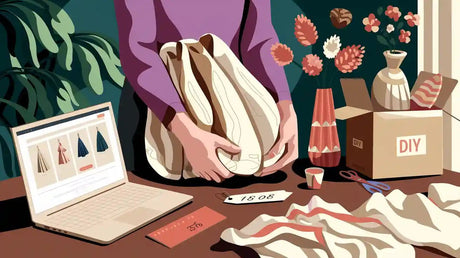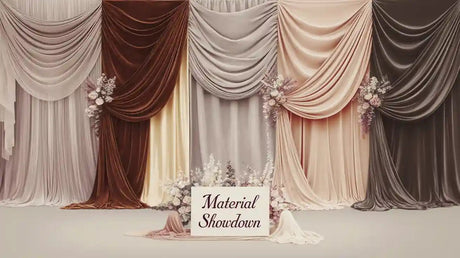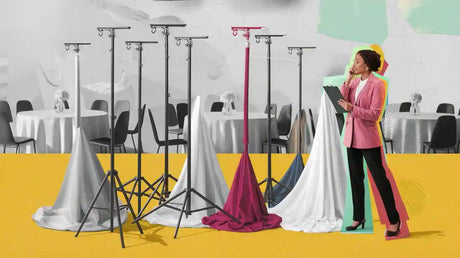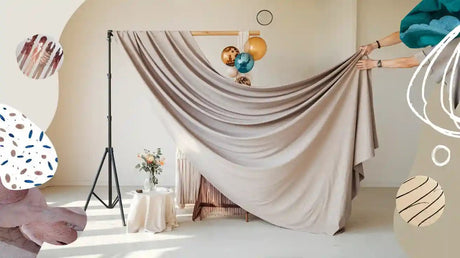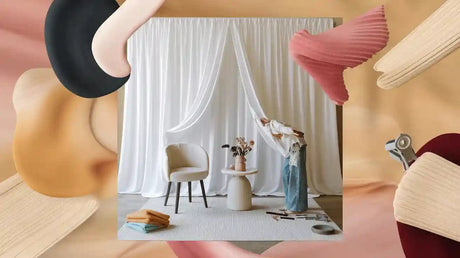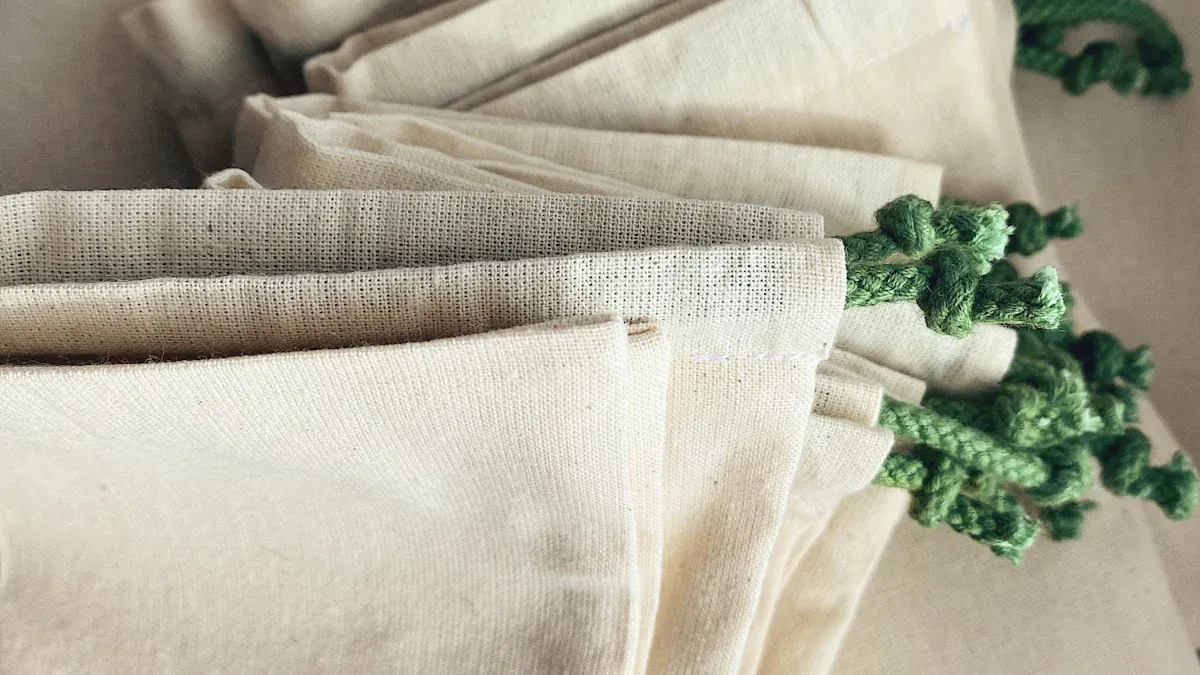
When you pick a white tablecloth made from natural materials, you help the environment. Labels like GOTS and OEKO-TEX show these tablecloths are eco-friendly. GOTS needs at least 70% organic fibers. OEKO-TEX checks for harmful chemicals to ensure safe production. These labels also support fair worker treatment, making them a smart choice. Strong and classic designs make them last longer. You can use these tablecloths for years without creating more trash.
Key Takeaways
Pick tablecloths made of organic cotton, linen, or hemp. These materials help the environment and lower pollution.
Check for labels like GOTS and OEKO-TEX. These show the tablecloths are safe and eco-friendly.
Take care of your tablecloths by washing in cold water. Avoid using bleach to make them last longer and cut waste.
Use white tablecloths for many events to save money. This also means you need fewer products, which helps the planet.
Buy from brands that treat workers fairly and use good practices. This supports fair work and eco-friendly production.
Eco-Friendly Materials for White Tablecloths
Natural and Renewable Options
Organic Cotton: A safe, soft, and eco-friendly fabric.
Organic cotton is a great choice for tablecloths. It avoids harmful chemicals and pesticides, keeping the environment and your home safe. This plant-based fabric uses less water than regular cotton. It also helps keep soil healthy. Its soft feel and breathable quality make it comfy and eco-friendly. Many people now prefer organic cotton because it’s better for the planet.
Linen: A strong, water-saving fabric from flax plants.
Linen comes from the flax plant and is very eco-friendly. It grows well in poor soil and doesn’t need much water. Linen lasts a long time, so you won’t need to replace it often. Its classic look and green production make it a top pick for sustainable tablecloths.
Hemp: A tough, earth-friendly, and biodegradable material.
Hemp is one of the most eco-friendly fabrics you can find. It grows quickly without pesticides and uses very little water. Hemp breaks down naturally and lasts for years. Its durability and environmental benefits make it a smart choice for green tablecloths.
Biodegradability and Compostability
How biodegradable fabrics cut down on trash.
Fabrics like organic cotton and linen break down naturally. This helps reduce the amount of trash in landfills. For example, cotton sheets used in gardens decompose in three months. Composting programs show natural fabrics can cut landfill waste by half. Choosing biodegradable materials helps keep the planet cleaner.
Compostable fabrics give nutrients back to the soil.
Compostable fabrics reduce waste and improve soil health. When materials like linen or bamboo break down, they add nutrients like calcium and zinc to the earth. A study showed composting 400 pounds of fabric created 275 pounds of rich soil. Picking compostable tablecloths helps the planet stay healthy.
Sustainable Production Processes
Important Certifications for Green Table Linens
GOTS: Makes sure fabrics are organic and eco-friendly.
The Global Organic Textile Standard (GOTS) ensures fabrics are mostly organic. At least 70% of the fibers must be organic to qualify. It also limits harmful chemicals during production to protect nature and people. Independent groups check to make sure standards are followed. Choosing GOTS-certified linens helps the planet and supports fair practices.
OEKO-TEX: Confirms fabrics are free from harmful chemicals.
OEKO-TEX certification proves that fabrics are safe and chemical-free. It focuses on using fewer harmful substances and protecting the environment. Certified linens go through strict testing to ensure safety. By picking OEKO-TEX-certified tablecloths, you help create a healthier world.
Fair Trade: Supports fair pay and safe working conditions.
Fairtrade certification ensures workers are paid fairly and work safely. It also encourages eco-friendly farming methods that help the planet. Buying Fairtrade-certified linens improves workers' lives and supports green practices. This certification shows care for both people and the environment.
Eco-Friendly Manufacturing Methods
Saving Water: Using less water during production.
Water-saving methods are important for making eco-friendly fabrics. For example, a factory in Turkey reuses water to cut down on waste. Another group in Bangladesh saves water during dyeing, conserving thousands of gallons each year. These methods reduce water use and lower the impact on the planet.
Natural Dyeing: Avoiding harmful dyes for safer fabrics.
Natural dyeing skips toxic chemicals, making products safer and cleaner. This method protects workers and reduces pollution. The bluesign® system checks fabrics to ensure no harmful chemicals are used. Choosing natural-dyed linens helps keep the earth and people healthy.
Ethical Practices in Making Sustainable Fabrics
Fair Work and Safe Conditions
Why fair pay and good worker treatment matter.
Picking sustainable fabrics helps workers get fair pay and respect. Fair pay lets workers afford basic needs and live better lives. Treating workers well also improves their rights and helps communities grow. Many companies now run programs to help local areas and support workers. These actions make life better for workers and help the fabric industry stay eco-friendly.
Keeping workplaces safe and healthy for workers.
Safe workplaces are key to ethical fabric production. Workers need clean spaces, safety gear, and fair hours. Certifications like Fairtrade Certified check if companies follow these rules. Buying Fairtrade linens helps ensure workers have safe jobs. Also, tools like textile software help reduce waste and keep production ethical.
Clear Supply Chains
Why clear supply chains help the planet and workers.
Clear supply chains let companies see how fabrics are made. This helps them cut waste and use resources wisely. Clear steps also lower harm to the planet by using green methods. For example, tracking tools help companies make eco-friendly changes. Supporting brands with clear practices pushes them to stay responsible.
Finding brands with ethical supply chains.
Brands with ethical supply chains often have trusted certifications. These prove materials are eco-friendly and workers are treated fairly. Outside groups check to make sure rules are followed. Choosing linens from these brands supports fair work and green practices. Look for labels like GOTS or Fair Trade to find responsible companies.
Durability and Longevity of Eco-Friendly Table Linens
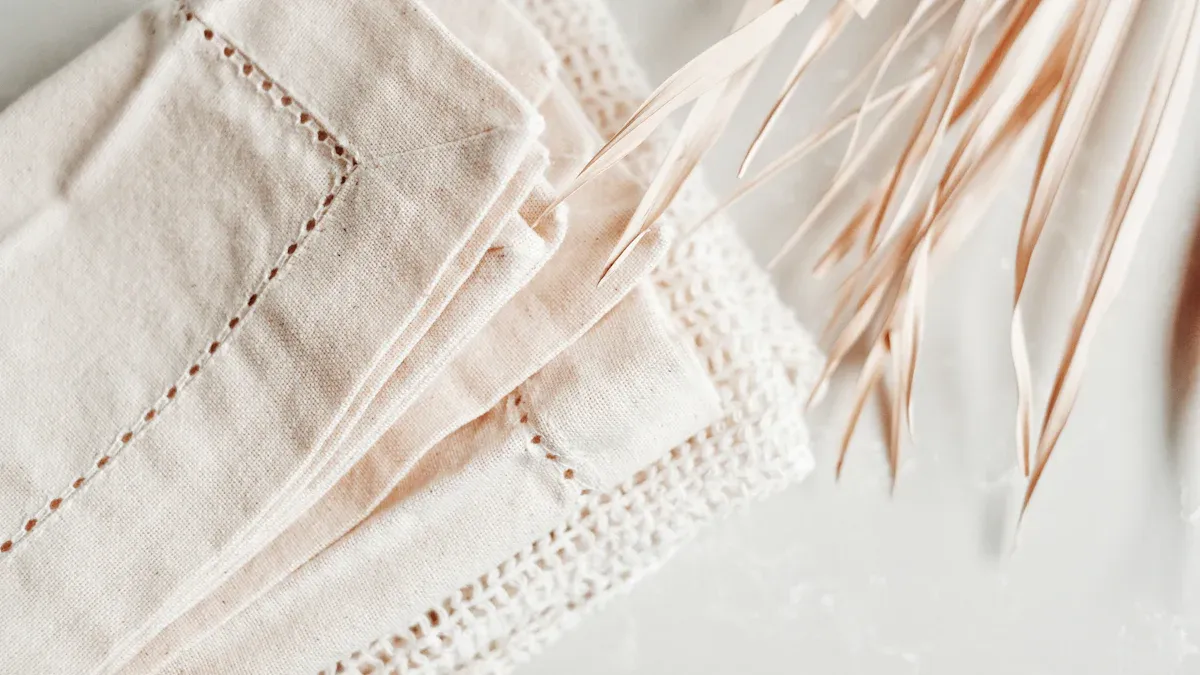
Strong Construction
Tough stitching and materials make linens last longer.
Picking table linens with strong stitching and sturdy materials is smart. These linens can handle regular use and washing without damage. Fabrics like organic cotton, linen, and hemp are very durable. They resist wear and keep looking good for a long time. Reinforced seams and careful crafting add to their strength. This means fewer replacements and less waste.
Material |
Benefits |
|---|---|
Organic Cotton |
Grown without harmful chemicals, making it safe and green. |
Linen |
Durable and eco-friendly, made from the flax plant. |
Hemp |
Grows fast, needs little water, and avoids pesticides. |
Bamboo |
Renewable and grows quickly with minimal water or chemicals. |
Quality Construction |
Strong seams and good craftsmanship make linens last longer, cutting waste. |
Less waste by using long-lasting tablecloths.
Reusable tablecloths with long lifespans help reduce trash. A well-made tablecloth can be used for many years. Unlike throwaway options, reusable linens lower landfill waste. Choosing biodegradable fabrics like organic cotton or linen helps even more. These materials break down naturally when no longer needed.
Easy Care and Maintenance
Tips for washing and storing white tablecloths.
Taking care of your tablecloths keeps them looking great. Follow these simple tips:
Wash in cold water to avoid shrinking or fading.
Clean stains quickly so they don’t set in.
Store in a cool, dry spot to prevent mildew or discoloration.
How good care makes linens last longer.
Caring for your linens keeps them in good shape for years. Regular cleaning and stain removal help them stay strong. Avoiding harsh chemicals also protects the fabric. This reduces the need to buy new ones often. Taking care of linens saves resources and supports eco-friendly living.
Tip: Proper care keeps your linens reusable and planet-friendly for a long time.
Aesthetic Versatility of Sustainable White Tablecloths
Timeless Designs
Simple colors and classic looks for lasting use.
White tablecloths never go out of style. Their plain colors match many home designs. Unlike trendy patterns, white linens stay stylish for years. This means you won’t need to replace them often, which helps the planet. Studies show people care about how things look when they shop. Picking classic designs makes your home look nice and reduces waste.
Evidence Type |
Description |
|---|---|
Looks Matter |
People often choose items based on how they look. |
Seasonal Buying |
Many buy new tablecloths for seasonal decor changes. |
Flexible designs for different events and styles.
White tablecloths work well for any event. Use them for fancy dinners or casual meals. Add colorful napkins or decorations to match the season. This makes them a smart and eco-friendly choice. More people now want products that are both useful and good for the planet. Brands that care about the environment are becoming more popular.
Evidence Type |
Description |
|---|---|
Eco-Friendly Choices |
People want products that help the environment. |
Brand Interest |
Shoppers like brands that focus on green practices. |
Multi-Purpose Use
White tablecloths for meals, parties, and decorations.
White tablecloths are great for many uses. They make weddings, birthdays, and holidays look special. Their simple design fits any setting, from fancy events to everyday meals. A nice table setup makes meals feel more enjoyable. Many tablecloths are easy to clean and resist stains. This makes them a long-lasting and useful item for your home.
Benefit |
Description |
|---|---|
Works Everywhere |
White tablecloths fit all kinds of events and meals. |
Better Dining |
A pretty table makes meals more fun and welcoming. |
Easy to Clean |
Most tablecloths can be washed in machines and resist stains. |
How using one tablecloth helps the planet.
Using one tablecloth for many things is eco-friendly. You don’t need to buy different ones for every event. This saves money and creates less trash. More people now want items made from eco-friendly materials. For example, sales of organic cotton tablecloths went up 18% last year. Choosing multi-use linens helps the planet and gives you a stylish, practical option.
Shoppers now pick fabrics that are better for the earth.
More people want tablecloths that can break down or be recycled.
Caring for the planet is changing how people shop for everything.
A white tablecloth that’s eco-friendly does more than look nice. Choosing sustainable linens helps the earth and supports fair production. Materials like organic cotton, linen, and hemp are better for nature. They cut down pollution and use renewable resources. Certifications like GOTS prove these fabrics meet eco-friendly and ethical rules.
Material |
How It Helps the Planet |
Extra Info |
|---|---|---|
Organic Cotton |
Made without harmful chemicals, safe for the environment. |
A favorite for people who care about the planet. |
Linen |
Strong and green, made from flax plants. |
One of the oldest fabrics with low environmental harm. |
Hemp |
Grows fast, needs little water, and avoids chemicals. |
A smart choice for eco-friendly tablecloths. |
Bamboo |
Grows quickly and uses little water or chemicals. |
Famous for being renewable and planet-friendly. |
These tablecloths are built to last and have classic designs. This means less waste and fewer replacements. Picking eco-friendly linens helps the planet and gives you stylish, useful table settings.
FAQ
What makes a white tablecloth eco-friendly?
Eco-friendly tablecloths are made from natural, renewable, and biodegradable fabrics. Materials like organic cotton, linen, or hemp are common choices. These fabrics skip harmful chemicals and are safer for the planet. Certifications like GOTS and OEKO-TEX prove they are sustainable and safe.
How do I know if a tablecloth is ethically made?
Check for labels like Fair Trade or GOTS on the product. These certifications mean workers are paid fairly and work in safe places. Ethical brands also have clear supply chains to show responsible production.
Can I compost my old white tablecloth?
Yes, if it’s made from biodegradable fabrics like organic cotton or linen. These materials break down naturally and improve soil health. Don’t compost tablecloths with synthetic fibers or chemical coatings.
How can I make my tablecloth last longer?
Wash it in cold water to avoid shrinking or damage. Skip bleach and clean stains quickly to keep it looking good. Store it in a cool, dry spot to prevent mildew. Taking care of your tablecloth helps it last longer.
Are sustainable tablecloths more expensive?
Yes, they might cost more because of better materials and fair practices. But they last longer, so you save money over time. Buying them also supports eco-friendly and ethical production.
Tip: Look for certifications and follow care tips to keep your tablecloth sustainable and long-lasting.

